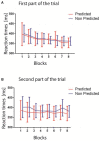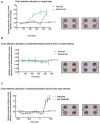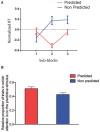Statistical Regularities Attract Attention when Task-Relevant
- PMID: 26903846
- PMCID: PMC4746264
- DOI: 10.3389/fnhum.2016.00042
Statistical Regularities Attract Attention when Task-Relevant
Abstract
Visual attention seems essential for learning the statistical regularities in our environment, a process known as statistical learning. However, how attention is allocated when exploring a novel visual scene whose statistical structure is unknown remains unclear. In order to address this question, we investigated visual attention allocation during a task in which we manipulated the conditional probability of occurrence of colored stimuli, unbeknown to the subjects. Participants were instructed to detect a target colored dot among two dots moving along separate circular paths. We evaluated implicit statistical learning, i.e., the effect of color predictability on reaction times (RTs), and recorded eye position concurrently. Attention allocation was indexed by comparing the Mahalanobis distance between the position, velocity and acceleration of the eyes and the two colored dots. We found that learning the conditional probabilities occurred very early during the course of the experiment as shown by the fact that, starting already from the first block, predictable stimuli were detected with shorter RT than unpredictable ones. In terms of attentional allocation, we found that the predictive stimulus attracted gaze only when it was informative about the occurrence of the target but not when it predicted the occurrence of a task-irrelevant stimulus. This suggests that attention allocation was influenced by regularities only when they were instrumental in performing the task. Moreover, we found that the attentional bias towards task-relevant predictive stimuli occurred at a very early stage of learning, concomitantly with the first effects of learning on RT. In conclusion, these results show that statistical regularities capture visual attention only after a few occurrences, provided these regularities are instrumental to perform the task.
Keywords: eye tracking; implicit learning; selective attention; statistical learning; visual attention.
Figures





References
LinkOut - more resources
Full Text Sources
Other Literature Sources

